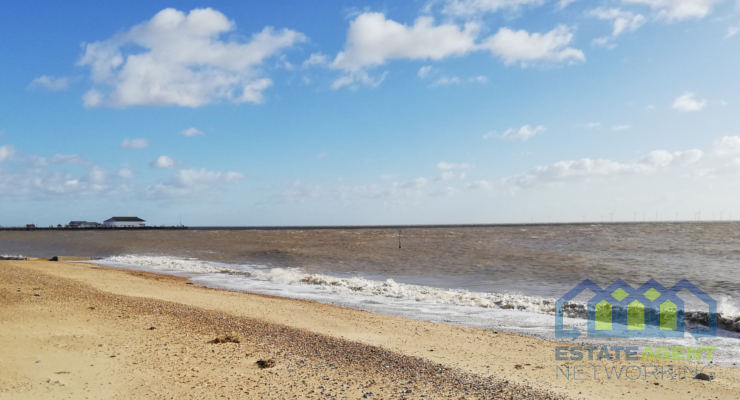Coastal areas see biggest affordability decline during pandemic
- Coastal local authorities have seen the biggest decline in first-time buyer affordability over the past three years, as house prices have outpaced average local salaries:
- Adur in West Sussex tops the list, where the average first-time buyer asking price is now 11.6 times the average local salary, up from 8.7 times before the pandemic
- Hertsmere is second, up from 9.6 times to 11.8 times the average local salary, and Richmondshire is third, up from 6.0 times to 8.2 times
- The majority of areas where first-time buyer affordability has improved are in London or commuter belt areas, due to lower house price growth and local salaries increasing over the past three years
- Across Great Britain the average first-time buyer type home has risen slightly from 6.9 times the average salary in 2019 to 7.2 times, though the average deposit needed has increased by 17%
- Demand for first-time buyer type properties is still up 32% versus 2019 despite affordability challenges and rising mortgage payments
New affordability analysis from the UK’s biggest property website Rightmove reveals that areas by the coast have seen the biggest decline in first-time buyer affordability during the pandemic, as strong house price growth has outpaced the change in local salaries.
Over half of the top 10 areas to see first-time buyer affordability decline are close to or by the coast, with Adur in West Sussex topping the list. The average asking price for a first-time buyer type home in Adur is now 11.6 times the average salary for the area, up from 8.7 times before the pandemic.
Hertsmere in Hertfordshire is second, where first-time buyer average asking prices are now 11.8 times the average local salary, compared with 9.6 times in 2019. Richmondshire in North Yorkshire is third, where an average first home is now 8.2 times the local salary, up from 6.0 times.
The majority of areas to see affordability improve during the pandemic are in London or in traditional commuter areas, albeit only slightly. Affordability has improved in these areas due to local salaries increasing at a faster pace than house prices.
Average asking prices in Lambeth are now 11.8 times the average salary for the area, compared with 13.3 times pre-pandemic. In Ealing, it is now 10.3 times compared with 11.7 times three years ago, and in Reading it is now 6.8 times compared with 7.8 times.
The data is based on an average solo first-time buyer, and assumes they have been able to save up a 10% deposit towards an average first-time buyer type property in their area (properties with two bedrooms or fewer). It also adjusts the latest available local salary data from ONS up to May 2022, by using the average national earnings increase, to get a current picture of local affordability.
Across Great Britain, an average first-time buyer type home is now 7.2 times the average salary, up from 6.9 times in 2019. The average 10% deposit for a first-time buyer home has risen by 17%, to £22,409.
Rising asking prices and interest rates means that the average monthly mortgage payment for new first-time buyers putting down a 10% deposit is now £1,032. This is 39% higher than the same time in 2019.
Despite affordability being stretched for many, enquiries for first-time buyer type properties are significantly up on the more normal market of 2019. Demand for first-time buyer type properties is up 32% compared with 2019, though it has dropped by 9% compared with the frenetic market of last year.
Tim Bannister, Rightmove’s Data Expert comments: ‘The current picture of how affordability has changed for new first-time buyers trying to take out a mortgage looks very different in different parts of Great Britain. It’s much harder for first-time buyers in the areas where prices jumped considerably over the past few years, especially when you add in six consecutive interest rate rises and average local salaries not keeping pace. We’re still seeing the effects of the pandemic whereby prices for homes near the sea are at a premium, with house prices quickly outpacing local salaries. However, despite stretched affordability, we’re not currently seeing rising prices and interest rates having a significant impact on first-time buyers wanting to move. Though demand for first-time buyer homes has expectedly eased from the heady levels of last year, it’s still significantly higher than it was back in 2019, suggesting many first-time buyers are factoring in rate rises into their own affordability.”
Kate Eales, head of regional agency at Strutt & Parker, said: “Affordability is a long-standing barrier for first time buyers looking at homeownership. There are several factors at play here. Across the country, the pipeline of new properties coming to the market for sale has not kept up with demand, and there is also a lack of suitable housing coming through for first-time buyers. A decade of mostly upward rents has put further pressure on saving for a deposit, and a rising market means that the goalposts have kept moving. All this has been exacerbated in recent months with rising interest rates, making mortgages more expensive, while inflation is driving down real income.
“It’s no surprise affordability will be felt most in coastal areas and around major urban centres. These locations are in high demand and first-time buyers will be competing with second steppers and downsizers, who are likely to be in a stronger financial position to secure a property. But those who are able to take their first step on the housing ladder largely remain undeterred.”
Mark Howell, Regional Sales Director at Michael Jones & Company in Sussex said: “We’ve seen an increase in the average age of first-time buyers as well as gifted deposits, which indicates that it could be taking first time buyers longer to acquire their deposits due to the rise in house prices. Salary levels have also slowed down in relation to house prices in the last few months, creating a wider gap between wages and affordability.”
Areas where first-time buyer affordability has declined
| Local authority |
Average first-time buyer asking price 2022 |
Asking price to income ratio in 2022 |
Asking price to income ratio in 2019 |
| Adur | £312,180 | 11.6 | 8.7 |
| Hertsmere | £392,016 | 11.8 | 9.6 |
| Richmondshire | £207,176 | 8.2 | 6.0 |
| West Devon | £221,816 | 9.1 | 7.1 |
| Torridge | £228,234 | 9.1 | 7.1 |
| Epsom and Ewell | £380,558 | 10.5 | 8.6 |
| East Suffolk | £236,480 | 8.8 | 7.0 |
| Chichester | £316,503 | 10.3 | 8.5 |
| Vale of Glamorgan | £201,704 | 6.7 | 4.9 |
| Cornwall | £243,634 | 9.7 | 8.1 |
Areas where first-time buyer affordability has improved
| Local authority |
Average first-time buyer asking price 2022 |
Asking price to income ratio in 2022 |
Asking price to income ratio in 2019 |
| Lambeth | £515,196 | 11.8 | 13.3 |
| Ealing | £409,125 | 10.3 | 11.7 |
| Reading | £259,224 | 6.8 | 7.8 |
| Oxford | £348,134 | 10.3 | 11.2 |
| Rochford | £296,257 | 7.5 | 8.4 |
| Newham | £382,428 | 11.0 | 11.8 |
| Hackney | £513,972 | 13.3 | 14.1 |
| Norwich | £190,164 | 5.8 | 6.5 |
| Cambridge | £357,683 | 9.1 | 9.7 |
| Southwark | £549,423 | 13.3 | 14.0 |









